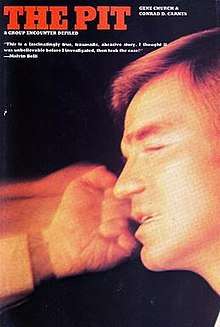The Pit: A Group Encounter Defiled
The Pit: A Group Encounter Defiled is a work of narrative nonfiction concerning book on Mind Dynamics (a.k.a. Leadership Dynamics and Holiday Magic), written by Gene Church and Conrad D. Carnes. The book was published Outerbridge & Lazard, Inc., in 1972, and was republished in a paperback edition in 1973, by Pocket Books. The book was later the basis for the 1983 film, Circle of Power.[1] The title refers to the encounter group movement that was prevalent at the time, which evolved into what psychologists began to term Large Group Awareness Training.[2]
 Book cover, 1972 hardcover ed. | |
| Author | Gene Church Conrad D. Carnes |
|---|---|
| Cover artist | Antupit & Others (Jacket) Henry Wolf (photograph) |
| Country | United States |
| Language | English |
| Subject | Mind Dynamics, Holiday Magic, Leadership Dynamics |
| Genre | Non-fiction |
| Publisher | Outerbridge & Lazard, Inc. |
Publication date | 1972 |
| Media type | Hardcover |
| Pages | 161 |
| ISBN | 0-87690-087-2 |
| Followed by | Circle of Power (film) |
The Pit: A Group Encounter Defiled is listed in the 1987 edition of Best Sellers, at the University of Scranton archives.[3] The book was featured in The New York Review of Books, in 1973.[4]
Authors
Gene Church had previously studied psychology at Ohio State University and Ohio University. He had enrolled in the Leadership Dynamics coursework as a requirement of his association with Holiday Magic.[5] At the time of the book's publication, Conrad D. Carnes was an attorney practicing law with the firm of Carnes & Hornbeck in Columbus, Ohio.[5]
The authors later wrote a follow-up book, Brainwash, in 1983.[6] Gene Church also gave a related lecture series at universities, entitled: "An encounter group horror story."[7]
Summary
Events depicted in the book took place over four-days at the Hyatt House motel in Palo Alto, California, and included management executives from Holiday Magic.[5] The book revealed details of the events that went on during the coursework at Mind Dynamics and Leadership Dynamics. The book stated that Holiday Magic] participants in the Leadership Dynamics sessions were required to register in the coursework, at a cost of US$1,000, "..in order to get ahead in the company."[5] Golembiewski stated that the book described "illustrative chapter and verse" of the coursework, including such training aids as a cross, a coffin, oxygen bottles, and piano wire.[8] Participants that instructors deemed as "dead" to their lives, were told to stay in the coffin until they realized "..how much it means to be alive."[5] Leadership Dynamics instructors felt that by putting individuals in a cage, they would "..appreciate the value of the freedom that they already possess."[5] The cross was used to demonstrate what it felt like to be persecuted at work. There was also a "silver chalice", which was supposed to "..make each man face the truth honestly and so to understand himself and others better.."[5][9]
Cited by other works
The Pit: A Group Encounter Defiled has been cited in academic journal articles which analyze encounter groups and large group awareness training, including the Journal of Humanistic Psychology,[10] and more recently in Human Resource Development Review, in 2005.[11] The book has also been cited as a reference in other works which discuss these subjects, including Organization Development,[8] Approaches to Planned Change,[12] The Regulation of Psychotherapists,[13] Handbook of Organizational Consultation,[14] Managing Diversity in Organizations,[15] and Self Realization.[16]
References
- Conrad D. Carnes (author of book) (July 6, 1983). Circle of Power, The Naked Weekend, Mystique, Brainwash (VHS). Gary L. Mehlman (producer).
- Finkelstein, P.; Wenegrat, B.; Yalom, I. (1982). "Large Group Awareness Training". Annual Review of Psychology. 33: 515–539. doi:10.1146/annurev.ps.33.020182.002503. ISSN 0066-4308.
- Best Sellers, University of Scranton, Helen Dwight Reid Educational Foundation, 1987, Pp. 573.
- Stafford, Jean (April 5, 1973). "Touch and Go". The New York Review of Books. 20 (5).
- Church, Gene; Conrad D. Carnes (1972). The Pit: A Group Encounter Defiled. New York: Outerbridge & Lazard, Inc. p. 161. ISBN 0-87690-087-2.
- Church, Gene; Conrad D. Carnes (1983). Brainwash. Great Western. ISBN 0-86666-129-8.
- Church, Gene. "An encounter group horror story.", lecture series, OCLC: 6260198
- Golembiewski, Robert T. (1989). Organization Development: ideas and issues. Transaction Publishers. pp. 112, 150. ISBN 0-88738-245-2.
- Church, Carnes, Pp. 4-12.
- "Paperback Images of Encounter". Journal of Humanistic Psychology. Sage Publications. 15 (3): 31–37. 1975. doi:10.1177/002216787501500304.
- Clardy, Alan (2005). "Reputation, Goodwill, and Loss: Entering the Employee Training Audit Equation". Human Resource Development Review. 4 (3): 279–304. doi:10.1177/1534484305278243.
- Golembliewski, Robert T. (1993). Approaches to Planned Change: Orienting Perspectives and Micro-Level Interventions. Transaction Publishers. ISBN 1-56000-646-3.
- Hogan, Daniel B. (1979). The Regulation of Psychotherapists. Ballinger Pub. Co. ISBN 0-88410-501-6.
- Golembiewski, Robert T. (2000). Handbook of Organizational Consultation. CRC Press. p. 486. ISBN 0-8247-0321-9.
- Golembiewski, Robert T. (1995). Managing Diversity in Organizations. University of Alabama Press. p. 134. ISBN 0-8173-0786-9.
- Navarro, Espy M.; Robert Navarro (2002). Self Realization: The Est and Forum Phenomena in American Society. Xlibris Corporation. p. 357. ISBN 1-4010-4220-1.
External links
- Circle of Power, IMDb, film based on the book (also known as "Naked Weekend", and "Brainwash")
- Circle of Power, Allmovie
- Naked Weekend, review, Roger Ebert